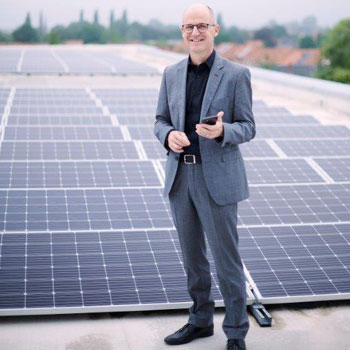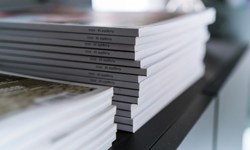
“Every copy reaching the reader must be of fantastic quality,” says Steven Renders, general manager of Belgium-based Roularta Printing.
Roularta Printing is part of Roularta Media Group, one of the largest magazine and newspaper publishers in Europe. They print Roularta’s own titles and those of other publishers, at their large print facility in Roeselare.
They have a number of UK publishing clients, including The Economist, and, as he and Export Sales Director Bart Declercq tell me when I made the short Eurostar journey to meet them in October, they want more.
What, I ask them, should publishers, whether based in the UK or mainland Europe, focus on when it comes to their print products?
1. Delivering consistent, high quality
Publishers, working with their printers, must “deliver supreme quality”, says Steven, across all aspects: paper choice, design and layout, clarity and sharpness, colour reproduction, stitching, wrapping and distribution.
It’s all very well having a perfect product roll off the press, but if its subsequent wrapping and transportation mean that the magazine arrives damaged or late to where it needs to be, then all the previous good work counts for nothing.
‘Quality’ must be seen in the round; good work in one area of the production process is quickly undone if it’s not matched by high performance in all other areas.
Quality is not the result of wishful thinking but of investment and tight quality control.
As part of a multi-year €100m investment programme, unveiled in 2007, says Bart, all of Roularta Printing’s machinery – which includes six rotary heatset printing presses – had been completely renewed by 2019.
Investment continues. Earlier this year, they invested €1.5m in supply chain management software and €4.5m in replacing their drying ovens – ovens which actually still had ten years’ life in them, but which as part of the company’s net-zero plans, were being replaced by more energy efficient ones which will reduce CO2 emissions by 14%.
When it comes to quality control, each print job at Roularta has a team of four on the press, plus a quality supervisor who keeps a close eye on the job, to make sure all aspects meet the quality standard. Furthermore, for time-sensitive publications, the timing of each stage of the production process from plating up to despatch are recorded and reported back to the publisher.
2. Demonstrating commitment to net-zero
“When choosing a printer, cost is important but it has to go hand in hand with sustainability,” says Steven.
Consumers are demanding it and increasingly eschewing products and suppliers that do not appear to be taking their environmental responsibilities seriously.
Governments are legislating for it. The EU aims to be climate-neutral by 2050, by which it means having an economy with net-zero greenhouse gas emissions. Roularta aims to get there ahead of schedule, by 2040. In the UK, the Climate Change Act commits the UK government by law to reducing greenhouse gas emissions by at least 100% of 1990 baseline levels by 2050.
Getting to net-zero requires, says Steven, firstly, taking steps to reduce your own carbon emissions, and then investing in carbon offsetting programmes to balance out any residual emissions.
There is a lot of talk in the industry, and a certain amount of greenwashing, when it comes to sustainability. After all, everyone says they’re sustainable…
When Steven said, “the right approach is twofold – first measure, then reduce,” I was minded of Peter Drucker’s famous dictum, “you can’t improve what you don’t measure”.
At Roularta Printing, which is ISO 50001 certified, they can precisely calculate the carbon footprint of each job. This is based on inputting information (paper tonnage and grade, energy consumption, transportation and other variables) into the ClimateCalc platform which provides a total emissions figure for each job.

Crucially, this total figure is also broken down into its constituent parts so that publisher and printer can easily identify those parts of their production process that are particularly emissions-heavy and take corrective action.
“Measurement must be followed by action,” says Steven, “and that is what we do ourselves. As already mentioned, we recently invested in new energy-efficient ovens ten years before we needed to. The roofs of our factory are covered in solar panels and, next year, we are installing a further 3,600 panels on adjacent land. Once that work is complete, 15% of the energy we use will be solar-generated. And, to offset our remaining emissions usage, we are also investing in forestry projects. Incidentally, these projects allow us to give our publishing clients the opportunity to sell carbon-neutral advertisements.”
Having taken substantive steps down the road to net-zero, it’s important to communicate that to your readers and advertisers and to keep them informed about progress. This will increase brand loyalty.
3. Ensuring business continuity
“Sustainability is about so much more than just using less energy,” says Steven: “it’s about taking steps to ensure your whole supply chain is robust and that you have contingency plans in place to deal with any interruption to business.”
“Our message to UK publishers is, don’t put all your eggs in one print basket – instead, use a mix of printers.”
“If you use only one and they go out of business or start to underperform, then you could be in a perilous situation. But if you have an existing relationship with another printer, then you can quickly and seamlessly shift production to them.”
“Having a second print partner up and running should be a strategic business aim,” says Bart.

According to Steven, in terms of business continuity, Roularta Printing is an exceptionally safe bet. Being owned by a publisher is, by definition, a quality guarantee as poor quality simply would not be tolerated by the company’s stakeholders.
Roularta Media Group (RMG) and Roularta Printing were founded together in 1954, so print publishing is in the DNA. The group has more than 1,300 employees and a total combined turnover of €300m. RMG is a market leader in magazine publishing (Dutch and French) in Belgium and also has sizable operations in the Netherlands and Germany.
The business is family owned. It was established by Willy De Nolf and the current executive chairman is his son, Rik de Nolf.
There is, says Steven, no private equity backer looking for an opportune moment to sell up; nor are there big loans and risks; “we’re here to stay”.
The company plans for the long term and its commitment to sustainability is further evidenced by its signing up to four of the UN’s Sustainable Development Goals; #4 (Quality education), #8 (Decent work and economic growth), #12 (Responsible consumption and production) and #13 (Climate action).
The company reports on progress against these goals annually, which means it is well positioned to comply with a new Belgian government requirement that large companies report annually, from 2025, on their environmental, social, and governance (ESG) performance.
The split between RMG work and their third party publishers is approximately 50:50. Steven emphasises that they see their third party publishers as partners, not clients, and he and Bart say they are keen to talk to UK publishers that share their long term goals and values.
Another UK publisher that came on board recently is the Financial Times, which has outsourced the printing of a significant portion of its magazines (How To Spend It, Art of Fashion, Business Education, FT Wealth) to Roularta.
Janet White, global director, print at the FT, explained why: “The choice of Roularta Printing as a strategic partner is based on various considerations, including a strong emphasis on sustainability, continuous investments in cutting-edge technologies, and the unparalleled quality standards maintained by Roularta Printing. Additionally, their long-term vision plays a crucial role in a rapidly consolidating market.”
Efficiencies
Before heading back to the train, I ask Steven and Bart if they had any tips on how publishers could reduce costs without compromising quality. They suggested:
- Print quantity: Carefully assess your print run. Print only what you know will be distributed and consider reducing the number of copies printed if they tend to go unsold or are frequently returned.
- Paper selection: Choose paper stock wisely. Lighter weight paper is often less expensive but can still maintain quality. Work with your printer to find the balance between cost and paper quality that fits your publication’s needs.
- Optimise dimensions to minimise paper waste: Optimise your publication layout and imposition to minimise paper waste and make the most efficient use of paper reel width.
- Reader feedback: Collect feedback from readers to understand what they value most in your publications. Tailor your content and printing decisions accordingly.
Let’s talk
With so much competition for people’s time, print quality is not optional, it’s a necessity, as is an ability to show your progress towards net-zero.
Steven Renders says: “If you are reviewing your print options and are focused on quality, sustainability and business continuity and are planning for the long term, then talk to us. We’re within easy reach of the UK; we can come to you, but you are also most welcome to come and see us at Roeselare.”
“If you are open to looking outside the UK, then we’re pretty much the first printer you come to!,” adds Bart Declercq, a regular visitor to these shores.

Bart Declercq
Export Sales Director, Roularta Printing
Tel: 0032 51 26 65 07
Mob: 0032 475 84 94 15
Email: bart.declercq@roulartaprinting.be
Website: www.roulartaprinting.be/en










